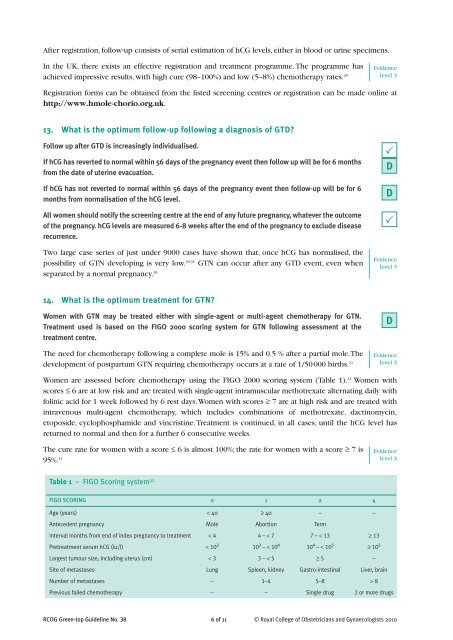The Management of Gestational Trophoblastic Disease - Green-top 38
The Management of Gestational Trophoblastic Disease - Green-top 38
The Management of Gestational Trophoblastic Disease - Green-top 38
You also want an ePaper? Increase the reach of your titles
YUMPU automatically turns print PDFs into web optimized ePapers that Google loves.
After registration, follow-up consists <strong>of</strong> serial estimation <strong>of</strong> hCG levels, either in blood or urine specimens.<br />
In the UK, there exists an effective registration and treatment programme. <strong>The</strong> programme has<br />
achieved impressive results, with high cure (98–100%) and low (5–8%) chemotherapy rates. 29<br />
Evidence<br />
level 3<br />
Registration forms can be obtained from the listed screening centres or registration can be made online at<br />
http://www.hmole-chorio.org.uk.<br />
13. What is the optimum follow-up following a diagnosis <strong>of</strong> GTD?<br />
Follow up after GTD is increasingly individualised.<br />
If hCG has reverted to normal within 56 days <strong>of</strong> the pregnancy event then follow up will be for 6 months<br />
from the date <strong>of</strong> uterine evacuation.<br />
If hCG has not reverted to normal within 56 days <strong>of</strong> the pregnancy event then follow-up will be for 6<br />
months from normalisation <strong>of</strong> the hCG level.<br />
All women should notify the screening centre at the end <strong>of</strong> any future pregnancy, whatever the outcome<br />
<strong>of</strong> the pregnancy. hCG levels are measured 6-8 weeks after the end <strong>of</strong> the pregnancy to exclude disease<br />
recurrence.<br />
Two large case series <strong>of</strong> just under 9000 cases have shown that, once hCG has normalised, the<br />
possibility <strong>of</strong> GTN developing is very low. 30,31 GTN can occur after any GTD event, even when<br />
separated by a normal pregnancy. 10<br />
P<br />
D<br />
D<br />
P<br />
Evidence<br />
level 3<br />
14. What is the optimum treatment for GTN?<br />
Women with GTN may be treated either with single-agent or multi-agent chemotherapy for GTN.<br />
Treatment used is based on the FIGO 2000 scoring system for GTN following assessment at the<br />
treatment centre.<br />
<strong>The</strong> need for chemotherapy following a complete mole is 15% and 0.5 % after a partial mole. <strong>The</strong><br />
development <strong>of</strong> postpartum GTN requiring chemotherapy occurs at a rate <strong>of</strong> 1/50 000 births. 11<br />
D<br />
Evidence<br />
level 3<br />
Women are assessed before chemotherapy using the FIGO 2000 scoring system (Table 1). 32 Women with<br />
scores ≤ 6 are at low risk and are treated with single-agent intramuscular methotrexate alternating daily with<br />
folinic acid for 1 week followed by 6 rest days. Women with scores ≥ 7 are at high risk and are treated with<br />
intravenous multi-agent chemotherapy, which includes combinations <strong>of</strong> methotrexate, dactinomycin,<br />
e<strong>top</strong>oside, cyclophosphamide and vincristine. Treatment is continued, in all cases, until the hCG level has<br />
returned to normal and then for a further 6 consecutive weeks.<br />
<strong>The</strong> cure rate for women with a score ≤ 6 is almost 100%; the rate for women with a score ≥ 7 is<br />
Evidence<br />
level 3<br />
95%. 11 6 <strong>of</strong> 11<br />
Table 1 – FIGO Scoring system 32<br />
FIGO SCORING 0 1 2 4<br />
Age (years) < 40 ≥ 40 – –<br />
Antecedent pregnancy Mole Abortion Term<br />
Interval months from end <strong>of</strong> index pregnancy to treatment < 4 4 – < 7 7 – < 13 ≥ 13<br />
Pretreatment serum hCG (iu/l) < 10 3 10 3 – < 10 4 10 4 – < 10 5 ≥ 10 5<br />
Largest tumour size, including uterus (cm) < 3 3 – < 5 ≥ 5 –<br />
Site <strong>of</strong> metastases Lung Spleen, kidney Gastro-intestinal Liver, brain<br />
Number <strong>of</strong> metastases – 1–4 5–8 > 8<br />
Previous failed chemotherapy – – Single drug 2 or more drugs<br />
RCOG <strong>Green</strong>-<strong>top</strong> Guideline No. <strong>38</strong> © Royal College <strong>of</strong> Obstetricians and Gynaecologists 2010
















